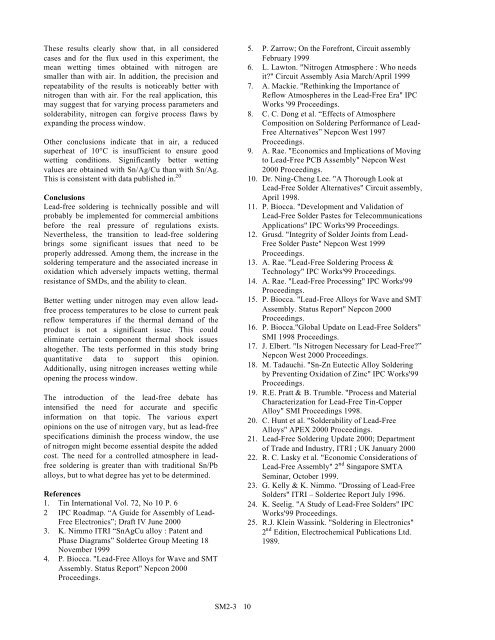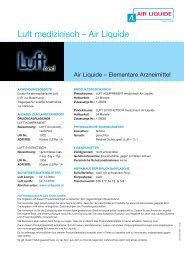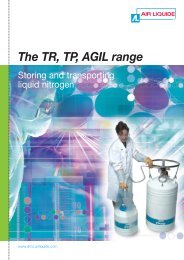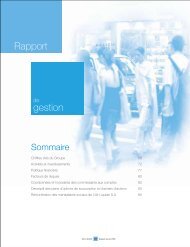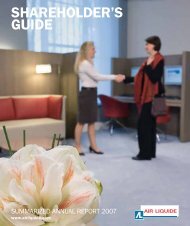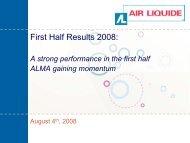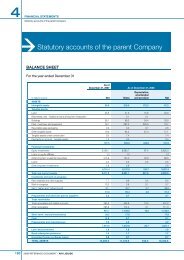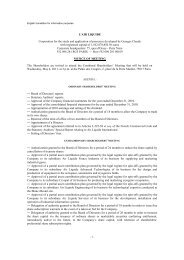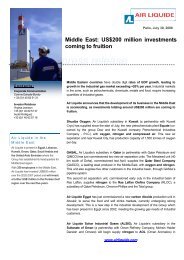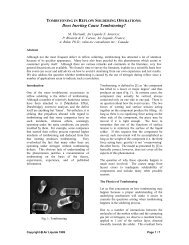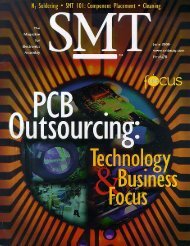Inert Soldering With Lead-Free Alloys: Review and Evaluation
Inert Soldering With Lead-Free Alloys: Review and Evaluation
Inert Soldering With Lead-Free Alloys: Review and Evaluation
You also want an ePaper? Increase the reach of your titles
YUMPU automatically turns print PDFs into web optimized ePapers that Google loves.
These results clearly show that, in all considered<br />
cases <strong>and</strong> for the flux used in this experiment, the<br />
mean wetting times obtained with nitrogen are<br />
smaller than with air. In addition, the precision <strong>and</strong><br />
repeatability of the results is noticeably better with<br />
nitrogen than with air. For the real application, this<br />
may suggest that for varying process parameters <strong>and</strong><br />
solderability, nitrogen can forgive process flaws by<br />
exp<strong>and</strong>ing the process window.<br />
Other conclusions indicate that in air, a reduced<br />
superheat of 10°C is insufficient to ensure good<br />
wetting conditions. Significantly better wetting<br />
values are obtained with Sn/Ag/Cu than with Sn/Ag.<br />
This is consistent with data published in. 20<br />
Conclusions<br />
<strong>Lead</strong>-free soldering is technically possible <strong>and</strong> will<br />
probably be implemented for commercial ambitions<br />
before the real pressure of regulations exists.<br />
Nevertheless, the transition to lead-free soldering<br />
brings some significant issues that need to be<br />
properly addressed. Among them, the increase in the<br />
soldering temperature <strong>and</strong> the associated increase in<br />
oxidation which adversely impacts wetting, thermal<br />
resistance of SMDs, <strong>and</strong> the ability to clean.<br />
Better wetting under nitrogen may even allow leadfree<br />
process temperatures to be close to current peak<br />
reflow temperatures if the thermal dem<strong>and</strong> of the<br />
product is not a significant issue. This could<br />
eliminate certain component thermal shock issues<br />
altogether. The tests performed in this study bring<br />
quantitative data to support this opinion.<br />
Additionally, using nitrogen increases wetting while<br />
opening the process window.<br />
The introduction of the lead-free debate has<br />
intensified the need for accurate <strong>and</strong> specific<br />
information on that topic. The various expert<br />
opinions on the use of nitrogen vary, but as lead-free<br />
specifications diminish the process window, the use<br />
of nitrogen might become essential despite the added<br />
cost. The need for a controlled atmosphere in leadfree<br />
soldering is greater than with traditional Sn/Pb<br />
alloys, but to what degree has yet to be determined.<br />
References<br />
1. Tin International Vol. 72, No 10 P. 6<br />
2 IPC Roadmap. “A Guide for Assembly of <strong>Lead</strong>-<br />
<strong>Free</strong> Electronics”; Draft IV June 2000<br />
3. K. Nimmo ITRI “SnAgCu alloy : Patent <strong>and</strong><br />
Phase Diagrams” Soldertec Group Meeting 18<br />
November 1999<br />
4. P. Biocca. "<strong>Lead</strong>-<strong>Free</strong> <strong>Alloys</strong> for Wave <strong>and</strong> SMT<br />
Assembly. Status Report" Nepcon 2000<br />
Proceedings.<br />
SM2-3 10<br />
5. P. Zarrow; On the Forefront, Circuit assembly<br />
February 1999<br />
6. L. Lawton. "Nitrogen Atmosphere : Who needs<br />
it?" Circuit Assembly Asia March/April 1999<br />
7. A. Mackie. "Rethinking the Importance of<br />
Reflow Atmospheres in the <strong>Lead</strong>-<strong>Free</strong> Era" IPC<br />
Works '99 Proceedings.<br />
8. C. C. Dong et al. “Effects of Atmosphere<br />
Composition on <strong>Soldering</strong> Performance of <strong>Lead</strong>-<br />
<strong>Free</strong> Alternatives” Nepcon West 1997<br />
Proceedings.<br />
9. A. Rae. "Economics <strong>and</strong> Implications of Moving<br />
to <strong>Lead</strong>-<strong>Free</strong> PCB Assembly" Nepcon West<br />
2000 Proceedings.<br />
10. Dr. Ning-Cheng Lee. "A Thorough Look at<br />
<strong>Lead</strong>-<strong>Free</strong> Solder Alternatives" Circuit assembly,<br />
April 1998.<br />
11. P. Biocca. "Development <strong>and</strong> Validation of<br />
<strong>Lead</strong>-<strong>Free</strong> Solder Pastes for Telecommunications<br />
Applications" IPC Works'99 Proceedings.<br />
12. Grusd. "Integrity of Solder Joints from <strong>Lead</strong>-<br />
<strong>Free</strong> Solder Paste" Nepcon West 1999<br />
Proceedings.<br />
13. A. Rae. "<strong>Lead</strong>-<strong>Free</strong> <strong>Soldering</strong> Process &<br />
Technology" IPC Works'99 Proceedings.<br />
14. A. Rae. "<strong>Lead</strong>-<strong>Free</strong> Processing" IPC Works'99<br />
Proceedings.<br />
15. P. Biocca. "<strong>Lead</strong>-<strong>Free</strong> <strong>Alloys</strong> for Wave <strong>and</strong> SMT<br />
Assembly. Status Report" Nepcon 2000<br />
Proceedings.<br />
16. P. Biocca."Global Update on <strong>Lead</strong>-<strong>Free</strong> Solders"<br />
SMI 1998 Proceedings.<br />
17. J. Elbert. "Is Nitrogen Necessary for <strong>Lead</strong>-<strong>Free</strong>?”<br />
Nepcon West 2000 Proceedings.<br />
18. M. Tadauchi. "Sn-Zn Eutectic Alloy <strong>Soldering</strong><br />
by Preventing Oxidation of Zinc" IPC Works'99<br />
Proceedings.<br />
19. R.E. Pratt & B. Trumble. "Process <strong>and</strong> Material<br />
Characterization for <strong>Lead</strong>-<strong>Free</strong> Tin-Copper<br />
Alloy" SMI Proceedings 1998.<br />
20. C. Hunt et al. "Solderability of <strong>Lead</strong>-<strong>Free</strong><br />
<strong>Alloys</strong>" APEX 2000 Proceedings.<br />
21. <strong>Lead</strong>-<strong>Free</strong> <strong>Soldering</strong> Update 2000; Department<br />
of Trade <strong>and</strong> Industry, ITRI ; UK January 2000<br />
22. R. C. Lasky et al. "Economic Considerations of<br />
<strong>Lead</strong>-<strong>Free</strong> Assembly" 2 nd Singapore SMTA<br />
Seminar, October 1999.<br />
23. G. Kelly & K. Nimmo. "Drossing of <strong>Lead</strong>-<strong>Free</strong><br />
Solders" ITRI – Soldertec Report July 1996.<br />
24. K. Seelig. "A Study of <strong>Lead</strong>-<strong>Free</strong> Solders" IPC<br />
Works'99 Proceedings.<br />
25. R.J. Klein Wassink. "<strong>Soldering</strong> in Electronics"<br />
2 nd Edition, Electrochemical Publications Ltd.<br />
1989.


